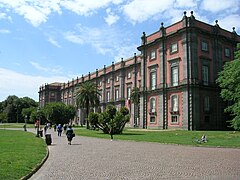Palace of Capodimonte
| Royal Palace of Capodimonte | |
|---|---|
| Reggia di Capodimonte | |

Royal Palace of Capodimonte façade
|
|
| General information | |
| Status | now used as a museum, National Gallery |
| Type | Palace |
| Architectural style | Italian Baroque, Neo-Classical |
| Location | Naples, Italy |
| Address | Via Miano 2, 80132 Naples NA, Italy |
| Construction started | 1738 |
| Completed | 1742 |
| Client | Charles III of Spain |
| Technical details | |
| Floor count | 3 |
| Design and construction | |
| Architect |
Antonio Canevari Giovanni Antonio Medrano Ferdinando Fuga Antonio Niccolini |
| Website | |
| Museo di Capodimonte official website (Italian) | |
|
Invalid designation
|
|
| Official name | Royal Palace of Capodimonte |
| Type | Non-movable |
| Criteria | Monument |
| State Party | Italy |
The Royal Palace of Capodimonte (Italian Reggia di Capodimonte) is a grand Bourbon palazzo in Naples, Italy, formerly the summer residence and hunting lodge of the kings of the Two Sicilies, and was one of the two Royal Palaces in Napoli. It today houses the National Museum of Capodimonte and art gallery of the city. "Capodimonte" means "top of the hill", and the palace was originally just outside the city, which has now expanded to surround it, and somewhat cooler than the city in summer.
In 1738, Charles VII king of Naples and Sicily (later Charles III, king of Spain) decided to build a hunting lodge on the Capodimonte hill, but then decided that he would instead build a grand palace (a Royal Palace, as in Italian "Reggia" means Royal), partly because his existing residence, the Palace of Portici, was too small to accommodate his court, and partly because he needed somewhere to house the fabulous Farnese art collection which he had inherited from his mother, Elisabetta Farnese, last descendant of the sovereign ducal family of Parma.
He commissioned Angelo Carasale, Giovanni Antonio Medrano and Antonio Canevari to build it. Work started in August 1738, but it was to take more than a century to complete, partly because of the difficulty of transporting piperno, the volcanic rock used, from the quarries in Pianura. In 1758, the first part of the palace was opened and the art collection was brought in. In 1759, Ferdinand I succeeded his father Charles and the following year he appointed the architect Ferdinando Fuga to oversee work on the palace and the grounds. In 1787, on the advice of Jacob Philipp Hackert, a laboratory for the restoration of paintings was created.
...
Wikipedia
